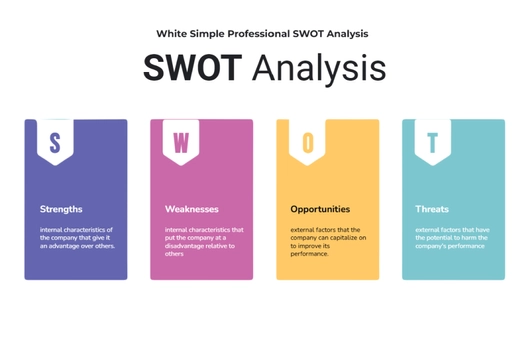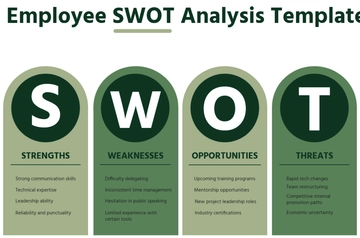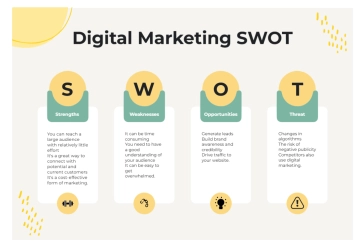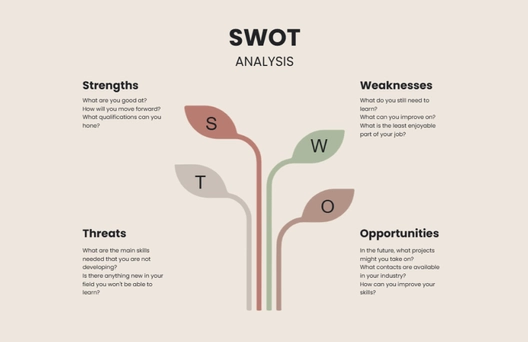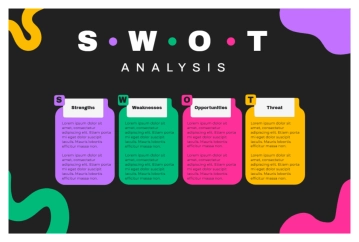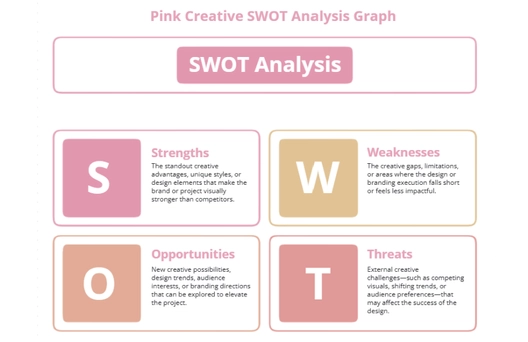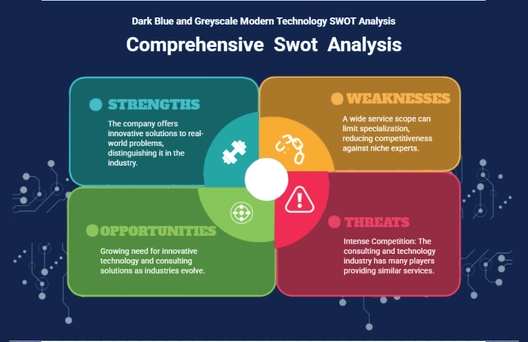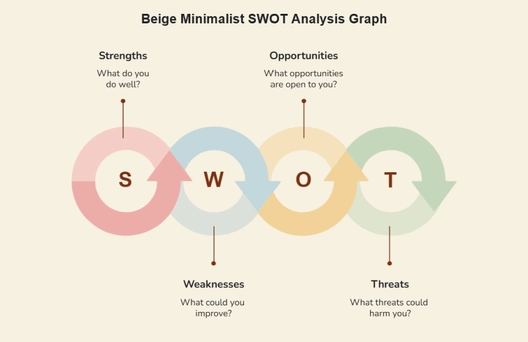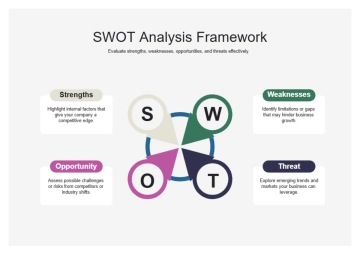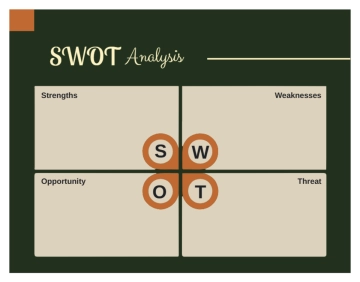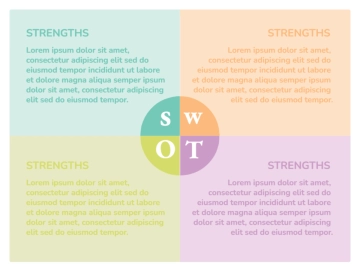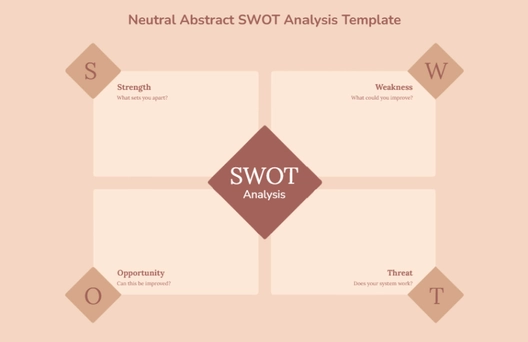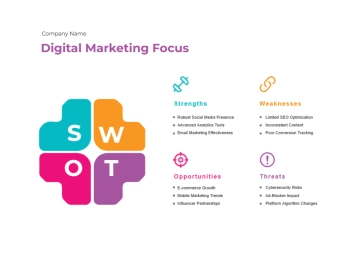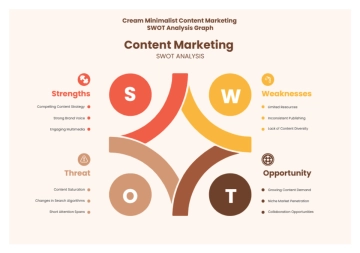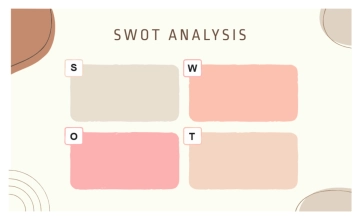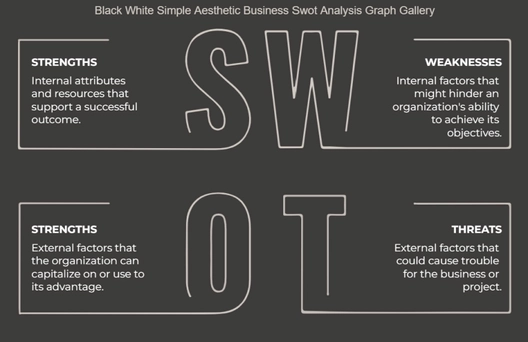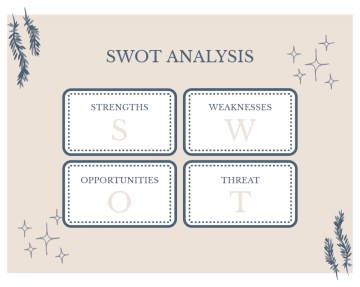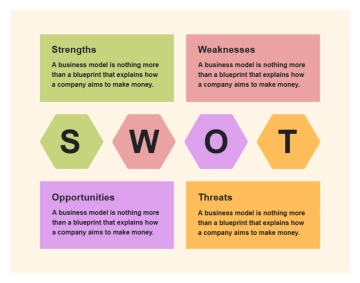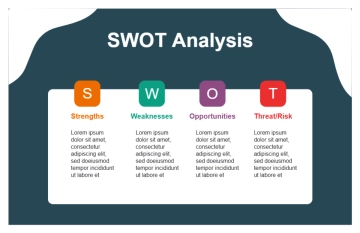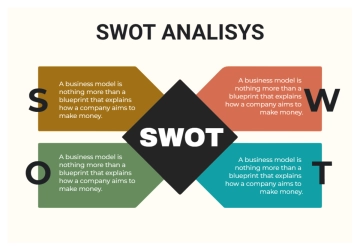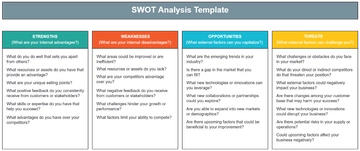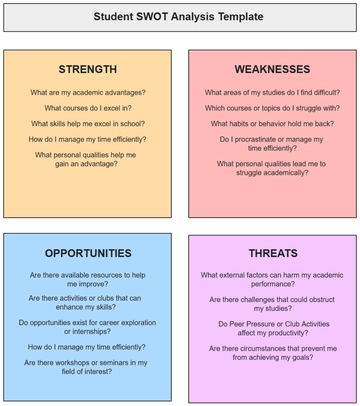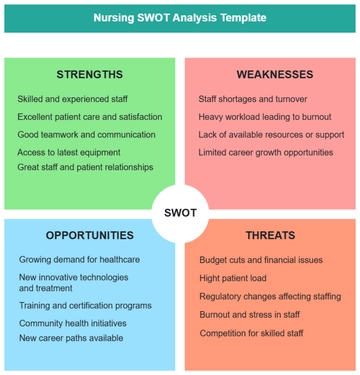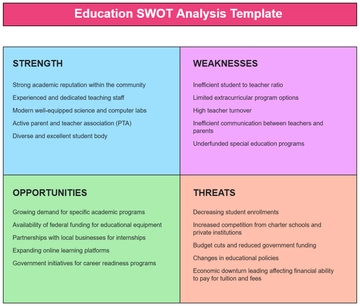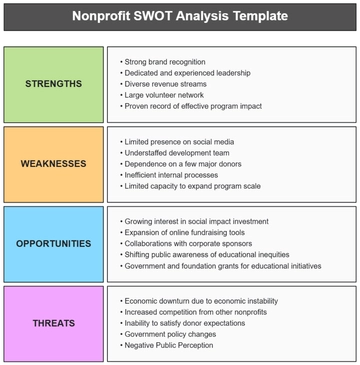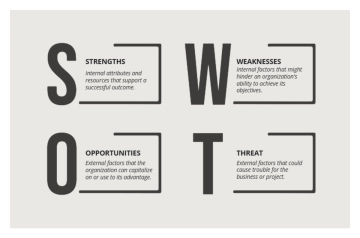Free Advertising SWOT Analysis
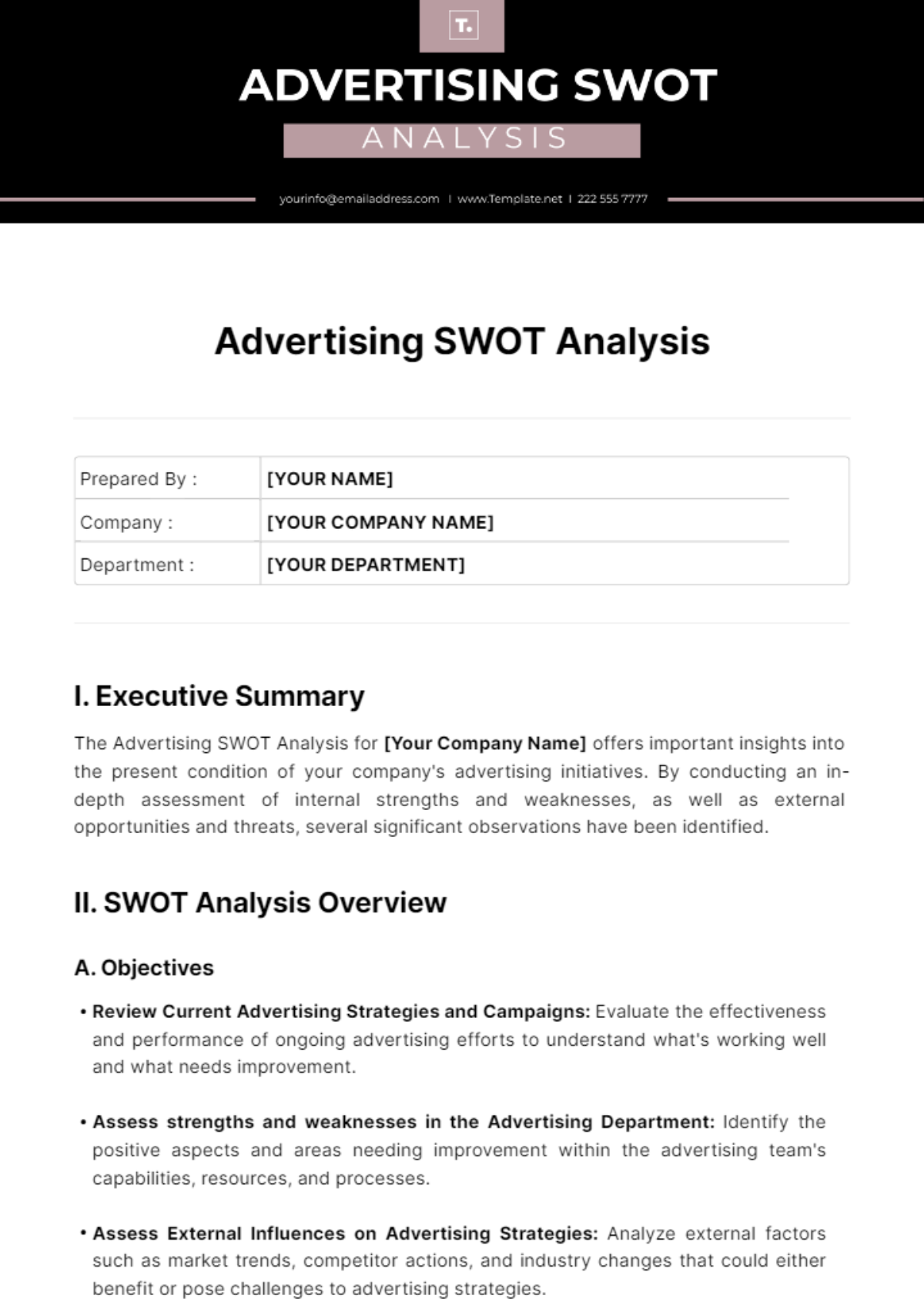
Prepared By : | [YOUR NAME] |
Company : | [YOUR COMPANY NAME] |
Department : | [YOUR DEPARTMENT] |
I. Executive Summary
The Advertising SWOT Analysis for [Your Company Name] offers important insights into the present condition of your company's advertising initiatives. By conducting an in-depth assessment of internal strengths and weaknesses, as well as external opportunities and threats, several significant observations have been identified.
II. SWOT Analysis Overview
A. Objectives
Review Current Advertising Strategies and Campaigns: Evaluate the effectiveness and performance of ongoing advertising efforts to understand what's working well and what needs improvement.
Assess strengths and weaknesses in the Advertising Department: Identify the positive aspects and areas needing improvement within the advertising team's capabilities, resources, and processes.
Assess External Influences on Advertising Strategies: Analyze external factors such as market trends, competitor actions, and industry changes that could either benefit or pose challenges to advertising strategies.
Develop Strategic Recommendations Based on the Analysis: Formulate actionable insights and suggestions based on the assessment to optimize advertising strategies, capitalize on strengths, and address weaknesses and external threats effectively.
III. Methodology
A. Data Sources
Market Research Reports: Leveraged industry-specific market research reports from reputable sources to understand market trends, consumer behavior, and competitor strategies.
Customer Feedback: Conducted surveys, and interviews, and analyzed customer feedback from multiple touchpoints such as social media, customer support interactions, and post-purchase surveys to gauge brand perception and satisfaction levels.
Internal Marketing Data: Analyzed internal marketing data, such as sales, campaign metrics, website analytics, and customer segments, to evaluate and enhance advertising strategies.
B. Analysis Techniques
SWOT Matrix: Created a structured SWOT (Strengths, Weaknesses, Opportunities, Threats) matrix to organize and analyze internal and external factors affecting [Your Company Name]'s advertising efforts. This matrix facilitated a clear identification of key factors in each category.
Competitive Analysis Conducted a thorough competitive analysis to benchmark [Your Company Name] against industry competitors. This analysis focused on identifying competitor strengths, weaknesses, market positioning strategies, and areas of differentiation in advertising approaches.
Trend Analysis: Analyzed market trends, consumer behavior, and new technologies in advertising, identifying future opportunities and threats to strategy.
IV. Analysis Details
A. Strengths
Innovative Digital Marketing Team: The digital marketing team demonstrates a track record of creativity and adaptability in utilizing digital channels effectively for advertising campaigns.
Examples
Description
Interactive
Content
Engaging formats: quizzes, polls, videos, and interactive ads.
Emerging
Platforms
Using TikTok, Clubhouse, and VR/AR for campaigns.
Targeted Digital
Advertising
Tailoring ads to specific demographics or behaviors.
Industry Trends
Monitoring
Incorporating the latest digital, tech, and consumer trends into strategies.
Assigning percentages to the effectiveness of each example can vary based on industry, target audience, and specific campaign goals.
Strong Brand Recognition in the Market: The company enjoys widespread awareness and positive perception among its target audience and industry peers.
Indicators: High brand recall rates, positive brand associations, consistent brand messaging across channels, and favorable customer reviews and feedback.
Successful Previous Campaigns with High Engagement Rates: Previous advertising campaigns have resonated well with the target audience, resulting in high levels of engagement and positive customer responses.
Metrics: Metrics such as click-through rates (CTR), conversion rates, social media interactions (likes, shares, comments), and customer feedback indicate campaign success.
Robust Social Media Presence and Follower Loyalty: The company maintains active and engaging social media profiles across key platforms, attracting and retaining a loyal base of followers.
Indicators: High follower counts, consistent posting schedules, meaningful interactions with followers, positive sentiment in social media mentions, and effective influencer collaborations.
B. Weaknesses
Limited Budget Allocation for High-Cost Advertising Channels: The company faces constraints in allocating sufficient funds to leverage high-cost advertising channels, limiting its reach and visibility in certain key markets or audience segments.
Impact: Reduced presence in premium advertising spaces, potential missed opportunities for targeting high-value customer segments, and limitations in competing with competitors investing heavily in such channels.
Dependence on Third-Party Platforms for Ad Distribution: The company relies heavily on third-party platforms (social media advertising platforms, and ad networks) for distributing its ads, which may limit control over ad placements and audience targeting.
Challenges: Lack of direct control over ad visibility and performance optimization, potential exposure to changes in third-party platform algorithms or policies affecting ad reach and effectiveness.
Insufficient Data Analytics Tools for Measuring Ad Performance: The company lacks advanced data analytics tools and capabilities to accurately measure and analyze the performance of advertising campaigns across various channels.
Issues: Difficulty in tracking key performance indicators (KPIs) such as ROI, attribution of conversions to specific ad campaigns, optimizing ad targeting and messaging based on data insights, and conducting meaningful A/B testing.
C. Opportunities
Emerging Markets with Untapped Customer Segments: Identify and enter new geographical markets or niche segments where the company's products/services are not yet widely available or recognized.
Benefits: Access to new customer demographics, increased market share, diversified revenue streams, and reduced dependency on saturated markets.
Technological Advancements Offering New Advertising Tools and Platforms: Leverage advancements such as AI-driven advertising, augmented reality (AR), virtual reality (VR), programmatic advertising, and data analytics tools for more targeted and effective advertising campaigns.
Advantages: Enhanced targeting precision, improved ROI through data-driven insights, personalized customer experiences, and staying ahead of competitors utilizing similar technologies.
Partnerships with Influential Media Networks and Content Creators: Collaborate with popular media networks, influencers, bloggers, and content creators relevant to the target audience to amplify brand reach and engagement.
Benefits: Access to larger audiences, increased brand credibility and trust, creative content collaborations, and leveraging influencer communities for word-of-mouth marketing and endorsements.
D. Threats
Increasing Competition from New Entrants and Established Brands: New companies entering the market and established brands expanding their advertising efforts can intensify competition for market share, customer attention, and advertising space.
Impact: Potential erosion of market share, pressure on pricing and profit margins, need for differentiation strategies, and heightened efforts to retain existing customers.
Changes in Advertising Regulations and Compliance Requirements: Evolving legal and regulatory landscapes regarding data privacy, ad content, targeting practices, and disclosure requirements can impact advertising strategies and campaign execution.
Challenges: Compliance costs, potential fines for non-compliance, limitations on data usage for targeting, and the need for frequent updates to adhere to changing regulations.
Economic Downturns Affecting Consumer Spending Patterns: Economic recessions, market downturns, or changing consumer sentiments can lead to reduced purchasing power and changes in consumer priorities and spending habits.
Impact: Decline in sales and revenue, budget constraints for advertising spend, shifts in consumer preferences towards value-oriented products/services, and the need for cost-effective advertising strategies.
V. Strategic Recommendations
Leverage Data Analytics to Optimize Ad Spend and Improve ROI
Utilize advanced analytics tools to track and analyze key metrics such as CTR, conversion rates, and customer acquisition costs across advertising campaigns.
Implement A/B testing to optimize ad creatives, messaging, and targeting strategies based on data-driven insights.
Use predictive analytics to forecast trends, anticipate consumer behavior changes, and allocate ad budgets effectively for maximum ROI.
Invest in new ad tech to outpace competitors.
Explore AI-powered advertising platforms for automated campaign optimization, audience segmentation, and personalized ad delivery.
Consider investing in programmatic advertising solutions for real-time bidding, targeted ad placements, and efficient budget allocation across multiple channels.
Experiment with immersive technologies like AR/VR for interactive ad experiences, enhancing brand engagement and customer retention.
Broaden marketing to new demographics and regions.
Conduct market research to identify untapped demographic segments with high growth potential and align advertising strategies accordingly.
Customize messaging, content, and ad placements to resonate with cultural nuances and preferences of new geographical markets.
Collaborate with local influencers, media outlets, and community networks to build brand awareness and credibility in new regions or target demographics.
VI. Conclusion
The SWOT analysis provides [YOUR COMPANY NAME] with critical insights into the internal and external factors affecting its advertising strategy. By addressing these areas systematically, the company can enhance its marketing efforts and strategically position itself for future growth and success.
- 100% Customizable, free editor
- Access 1 Million+ Templates, photo’s & graphics
- Download or share as a template
- Click and replace photos, graphics, text, backgrounds
- Resize, crop, AI write & more
- Access advanced editor
Strengthen your advertising strategies with the Advertising SWOT Analysis Template from Template.net. This fully editable and customizable template allows for a thorough analysis of strengths, weaknesses, opportunities, and threats. Easily tailored in our Ai Editor Tool to fit your unique needs, it ensures a comprehensive evaluation of your advertising approach for optimal results.
